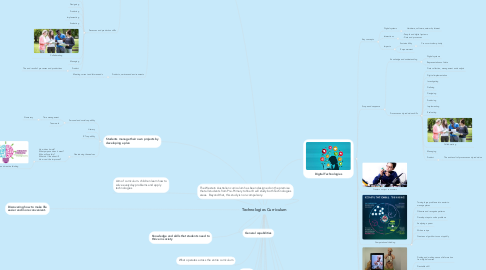
1. Aim of curriculum- children learn how to solve everyday problems and apply technologies
2. Students manage their own projects by developing a plan
2.1. Personal and social capability
2.1.1. Time management
2.1.1.1. Numeracy
2.1.2. Teamwork
2.2. Literacy
2.3. ICT capability
2.4. Questioning themselves
2.4.1. -How does it work? -What purpose does it meet? -Who will use this? -What do I like about it? -How can it be improved?
2.4.1.1. Critical and creative thinking
3. Knowledge and skills that students need to thrive in society
4. Intercultural understanding
5. Information and communication technologies (ICT) capability
5.1. ICT capability vs digital technologies
5.1.1. ICT capability = how to use ICT
5.1.1.1. How to play a game
5.1.2. Digital technologies = learning how to design and work with ICT on a deeper level
5.1.2.1. How to create a game
6. Numeracy
7. Literacy
8. What operates across the entire curriculum
9. Design and technologies
9.1. Design thinking
9.1.1. Cycle of -Empathize -Define -Ideate -Prototype -Test
9.2. Scope and sequence
9.2.1. Knowledge and understanding
9.2.1.1. Engineering principles and systems
9.2.1.1.1. How do forces create: -Light -Sound -Heat -Movement
9.2.1.2. Food specialisations
9.2.1.2.1. Nutrition
9.2.1.2.2. Characteristics of food
9.2.1.2.3. Applying knowledge
9.2.1.2.4. Managing time and budgets
9.2.1.3. Food and fibre production
9.2.1.3.1. Producing and developing food and fibre to create products
9.2.1.4. Materials and technologies specialisation
9.2.1.4.1. Textiles
9.2.1.4.2. Metals
9.2.1.4.3. Wood
9.2.1.4.4. Plastics
9.2.1.5. Technologies and society
9.2.2. Processes and production skills
9.2.2.1. Investigating
9.2.2.2. Defining
9.2.2.3. Designing
9.2.2.4. Producing
9.2.2.5. Implementing
9.2.2.6. Evaluating
9.2.2.7. Collaborating
9.2.2.8. Managing
9.2.2.9. Product
9.2.2.9.1. The end result of processes and productions
9.3. Products, services and environments
9.3.1. Meeting current and future needs
10. The Western Australian curriculum has been designed on the premise that all students from Pre-Primary to Year 8 will study both Technologies areas. Beyond that, this study is non-compulsory.
11. General capabilities
12. Discovering how to make life easier and more convenient.
13. Ethical understanding
14. Personal and social capability
15. Critical and creative thinking
16. Digital Technologies
16.1. Key concepts
16.1.1. Digital systems
16.1.1.1. Hardware, software, networks, Internet
16.1.2. Interactions
16.1.2.1. -People and digital systems -Data and processes
16.1.3. Impacts
16.1.3.1. Sustainability
16.1.3.1.1. Cross curriculum priority
16.1.3.2. Empowerment
16.2. Scope and sequence
16.2.1. Knowledge and understanding
16.2.1.1. Digital systems
16.2.1.2. Representations of data
16.2.2. Processes and production skills
16.2.2.1. Data collection, management and analysis
16.2.2.2. Digital implementation
16.2.2.3. Investigating
16.2.2.4. Defining
16.2.2.5. Designing
16.2.2.6. Producing
16.2.2.7. Implementing
16.2.2.8. Evaluating
16.2.2.9. Collaborating
16.2.2.10. Managing
16.2.2.11. Product
16.2.2.11.1. The end result of processes and production
16.3. Creators not just consumers
16.4. Computational thinking
16.4.1. Turning large problems into easier to manage pieces
16.4.2. Observe and recognise patterns
16.4.3. Develop steps to solve problems
16.4.4. Analysing a poem
16.4.5. Write a recipe
16.4.6. Create an algorithm to count quickly
16.5. Digital literacy
16.5.1. Finding and making sense of information from digital sources
16.5.2. Desirable skill
16.6. Digital citizenship
16.6.1. Appropriate behaviours when using digital technologies
16.6.1.1. -Being polite -Don't share sensitive information -Safety of self and others
16.6.1.1.1. Netiquette
16.6.1.2. Positive digital footprint
17. Cross curriculum priorities
17.1. Aboriginal and Torres Strait Islander histories and cultures
17.2. Asia and Australia's engagement with Asia
17.3. Sustainability
18. Algorithms
18.1. The description of the process and decisions required to solve a problem
18.2. Used in both strands of the Technologies curriculum
19. Integration across the curriculum
19.1. Maths
19.1.1. Angles
19.1.2. Directions
19.1.3. Rotations
19.2. English
19.2.1. Procedural text
19.3. Science
19.3.1. Experiment method
19.4. Food technology
19.4.1. Recipe

